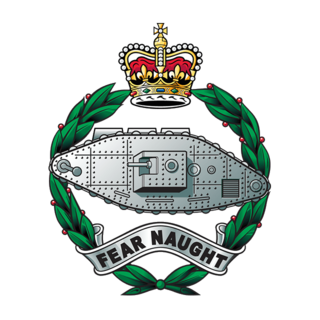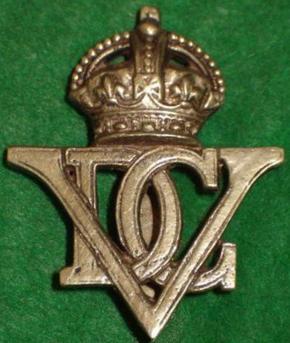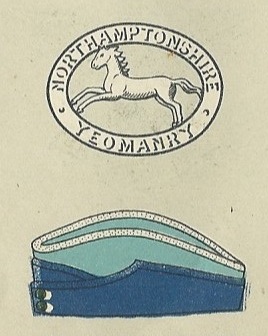
The Royal Tank Regiment (RTR) is the oldest tank unit in the world, being formed by the British Army in 1916 during the First World War. Today, it is the armoured regiment of the British Army's 12th Armoured Infantry Brigade. Formerly known as the Tank Corps and the Royal Tank Corps, it is part of the Royal Armoured Corps.

The 5th Royal Inniskilling Dragoon Guards was a cavalry regiment of the British Army formed in 1922 by the amalgamation of the 5th Dragoon Guards and the 6th (Inniskilling) Dragoons. It served in the Second World War and the Korean War. In August 1992, as a consequence of the Options for Change defence cuts, the regiment was amalgamated with the 4th/7th Royal Dragoon Guards to form the Royal Dragoon Guards.

The Royal Canadian Dragoons (RCD) is the senior armoured regiment of the Canadian Army by precedence. It is one of three armoured regiments in the Regular Force and forms part of the Royal Canadian Armoured Corps.

1st Armoured Regiment is an armoured regiment of the Australian Army and is the senior regiment of the Royal Australian Armoured Corps. Formed as a tank unit in the new Australian Regular Army on 7 July 1949, the regiment subsequently saw service during the Vietnam War operating Centurion tanks. Currently the unit is based in Edinburgh, South Australia as part of the 9th Brigade. As part of the Plan Beersheba reorganisation, the unit has become one of three Armoured Cavalry Regiments (ACRs) assigned to the Army's multirole combat brigades in Brisbane, Darwin and Townsville. Each ACR is equipped with M1A1 tanks and ASLAV light armoured vehicles.

The 15th/19th The King's Royal Hussars was a cavalry regiment of the British Army. The regiment was formed by the amalgamation of the 15th The King's Hussars and the 19th Royal Hussars in 1922 and, after service in the Second World War, it was amalgamated with the 13th/18th Royal Hussars to form the Light Dragoons in 1992.

The 6th Royal Tank Regiment was a regiment of the Royal Tank Regiment, of the British Army, until 1959. It originally saw action as 6th Battalion Tank Corps in 1917.

The 4th/7th Royal Dragoon Guards was a cavalry regiment of the British Army formed in 1922. It served in the Second World War. However following the reduction of forces at the end of the Cold War and proposals contained in the Options for Change paper, the regiment was amalgamated with the 5th Royal Inniskilling Dragoon Guards, to form the new Royal Dragoon Guards in 1992.

The 17th/21st Lancers was a cavalry regiment of the British Army. It was formed in England by the amalgamation of the 17th Lancers and the 21st Lancers in 1922 and, after service in the Second World War, it amalgamated with the 16th/5th The Queen's Royal Lancers to form the Queen's Royal Lancers in 1993.
The 16th/5th The Queen's Royal Lancers was a cavalry regiment of the British Army. It was formed by the amalgamation of the 16th The Queen's Lancers and the 5th Royal Irish Lancers in 1922. The reason for the uniquely atypical regimental title was that the 5th had been re-raised in 1858 almost 60 years after being disbanded, and when re-raised took precedence after the 17th Lancers. After service in the Second World War and the Gulf War, the regiment amalgamated with the 17th/21st Lancers to form the Queen's Royal Lancers in 1993.

The 2nd Royal Tank Regiment was an armoured regiment of the British Army. It was part of the Royal Tank Regiment, itself part of the Royal Armoured Corps and the 1st Mechanized Brigade.

The 1st Royal Tank Regiment was an armoured regiment of the British Army. It is part of the Royal Tank Regiment, itself part of the Royal Armoured Corps and operationally under 12th Armoured Infantry Brigade.

The 3rd Royal Tank Regiment was an armoured regiment of the British Army in existence from 1917 until 1992. It was part of the Royal Tank Regiment, itself part of the Royal Armoured Corps. It originally saw action as C Battalion, Tank Corps in 1917.

The 4th Royal Tank Regiment was an armoured regiment of the British Army from its creation in 1917, during World War I, until 1993. It was part of the Royal Tank Regiment, itself part of the Royal Armoured Corps.
The 45th Royal Tank Regiment was an armoured regiment of the British Territorial Army that fought at the Battle of Alamein during World War II and continued to serve during the 1950s.

The Northamptonshire Yeomanry was a Yeomanry regiment of the British Army, formed in 1794 as volunteer cavalry. It served in the Second Boer War, the First World War and the Second World War before being reduced to squadron level in 1956. It ceased to have a separate existence in 1971.
General Sir Alan Jolly, was a senior officer of the British Army who served as Quartermaster-General to the Forces from 1966 to 1969.
Lieutenant General Sir Allan Macnab Taylor, was a British Army officer who commanded the 1st Division from 1968 to 1970.

The 144th Regiment Royal Armoured Corps was an armoured regiment of the British Army. Originally raised during World War II as a battalion of the East Lancashire Regiment it was later transferred to the Royal Armoured Corps. It fought in the campaign in North-West Europe, from June 1944 to May 1945.
The Leeds Rifles was a unit of the 19th century Volunteer Force of the British Army that went on to serve under several different guises in the World Wars of the 20th century. In the First World War, both battalions served as infantry on the Western Front. They were later converted into an anti-aircraft and tank units, and fought in North Africa, Italy, and Burma during the Second World War.
Major-General Arundell Rea Leakey, was an officer in the British Army. He served in the Royal Tank Regiment in the Second World War, in North Africa, Italy and France. He later served in Korea, in the Arab Legion, and commanded a brigade in the British Army of the Rhine in the 1960s. He served as Director-General of Fighting Vehicles and finally as the commander of British troops in Malta and Libya. He retired in 1966, and became Director of the Wolfson Foundation. An autobiography, Leakey's Luck, was published in 1999.









